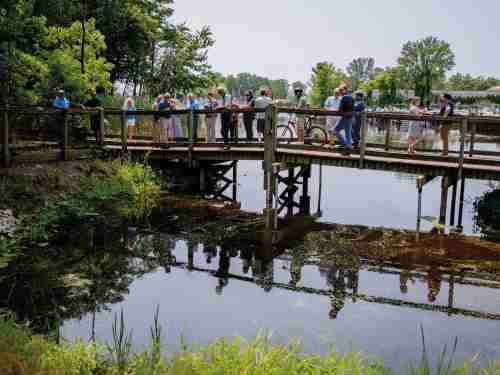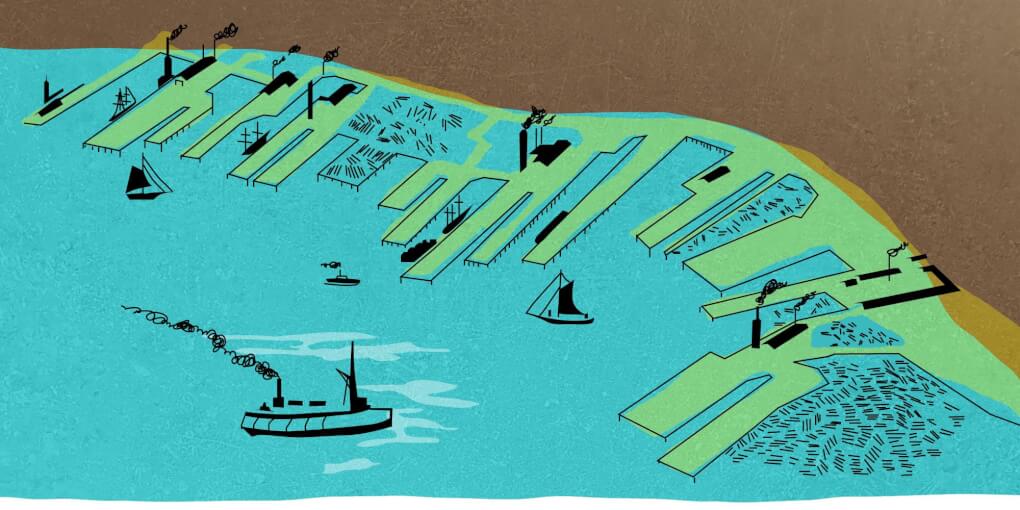As visitors approach the Muskegon Lake Nature Preserve, they may not be aware of the one of the last vestiges to the lake’s polluted history right underneath their feet.
To access the preserve’s trailhead, guests can walk across a wooden footbridge, anchored on one side by the unpleasant byproduct of one of the lake’s former foundries — slag, the industrial waste spewed out in the creation of iron and steel.
It is a stark reminder of Muskegon Lake’s incredible transformation since being designated as an Area of Concern by the U.S. Environmental Protection Agency in 1985, one of 47 Great Lakes sites to earn the ignominious selection.

Members of the Muskegon Lake Watershed Partnership and community members tour the Muskegon Lake Nature Preserve to talk about the lake’s restoration efforts.

Degradation of population for fish and wildlife

Loss of habitat for fish and wildlife
For nearly 40 years, stakeholders and partners have collaborated to restore the lake and return it to its natural beauty, a beauty that hasn’t been seen since the foundries and sawmills first began to populate the area. Grand Valley’s Annis Water Resources Institute (AWRI) is at the heart of the restoration effort. The AWRI has been monitoring, studying and protecting Muskegon Lake, Michigan’s waterways and the Great Lakes since it was established in 1986.
“I can’t stress enough how important it is for AWRI to be here on Muskegon Lake, especially considering we’ve been here for nearly four decades, because without a good scientific basis of this ecosystem and its changes, it would be a very difficult process,” said Bopi Biddanda, professor of water resources.
“I think it’s unparalleled the kind of guidance we can provide for sustainable restoration of this ecosystem. And that’s what makes it more valuable. All the more reason why we should be here not just on Muskegon Lake, but also on the shores of the Great Lakes.”
AWRI’s state and federal partners agree. The work of the Michigan Department of Environment, Great Lakes and Energy (EGLE) would be considerably different if not for AWRI’s support, said Stephanie Swart, the AOC coordinator for EGLE.
“It’s been fantastic having AWRI because we have relationships that are immediate,” Swart said. “I don’t have to go to Michigan State and see if they have staff that happen to be working here. Grand Valley is here. They are working in Muskegon. They have graduate students who can be put on a project if I need help.”
After years of laborious efforts, Muskegon Lake is nearing a momentous achievement — official removal from the EPA’s Area of Concern list.
The Muskegon Lake Watershed Partnership announced July 11 that two target areas, or Beneficial Use Impairments (BUIs), have been addressed, inching the lake closer toward delisting. The two most recent BUIs addressed the degradation of population for fish and wildlife and their loss of habitat.
“It’s exciting, though it doesn’t mean we’ve arrived,” said Dennis Kirksey, chair of the Muskegon Lake Watershed Partnership, following his July 11 announcement at AWRI. “It doesn’t mean that the battle is done. It just means we are a lot closer to where we want to be and where we were 10, 15, 20 years ago.”


Overcoming a polluted history
Along with the foundries, more than 35 sawmills once ringed the lake’s shoreline, harvesting the logs that floated downstream on the Muskegon River. For decades, the sawmills and foundries used the lake to discharge their byproducts and waste, creating an ecosystem that bubbled with chemicals and depopulated the fish and wildlife.
Rick Rediske, AWRI senior project manager and professor, was a graduate student in the mid-1970s when he first studied Muskegon Lake. Already bubbling with a cauldron of toxic chemicals, the lake was also used as disposal for Muskegon’s wastewater, Rediske said.
Rediske recalled the construction of a treatment facility by the City of Muskegon, at the time, was planned to divert wastewater from the lake. Instead, the wastewater would be treated, aerated and sprayed onto land where the soil would treat the water. But even under these intentions, the water seeped through the soil and trickled back into the lake.
“I remember going out on the lake, and it still didn’t look good,” Rediske said. “At that point, the paper mill had a release of sulfur dioxide, and we were all choking on the boat from the air pollution. I swore that I would never come back to Muskegon, but I did.
“The lake had fish advisories, so you couldn’t eat the fish because of the contaminants in them. There was floating scum and a lot of odor. There were anoxic conditions, so the chlorophyll was really high and lots of algae blooms. It was not a healthy lake.”
Rediske has spent his career at AWRI, researching the chemical conditions of Muskegon Lake and serving as one of its stewards. Along with his work at AWRI, he was also chair of the Muskegon Lake Public Advisory Council, building the delisting criteria needed to put the lake back on track. As cleanup began on Ruddiman Creek, one of the lake’s tributaries, Rediske acted as liaison between the EPA and Muskegon’s citizens.
“By being here in Muskegon, we could be an actual part of the process,” Rediske said. “We were a local stakeholder instead of working on campus, even though it’s 35 miles away.
“The fact that all of our scientists were here every day, we could engage the community and do a lot more significant interactions with our projects.”
One of Rediske’s colleagues, professor Bopi Biddanda, is also keeping a close eye on the lake’s health, thanks to an observatory buoy stationed in the middle of Muskegon Lake. Informally referred to as “Bopi’s Buoy,” instruments provide information on temperature, oxygenation, pH and additional data. Biddanda discusses the health of Great Lakes water in this story.
Though the buoy is not operational this summer due to lack of funding, another sensor is positioned two meters off the AWRI dock and reports data back to Biddanda and his team.
“We have to be able to understand an ecosystem in order to be able to safely manage it, and I think that’s where AWRI comes in,” Biddanda said. “We contribute fundamental knowledge about the what, how and so on. Then we can plan for the ifs and buts.”

After decades of pollution, Muskegon Lake is expected to be removed from the EPA’s Area of Concern list in 2024, thanks to the efforts of the AWRI and its partners. A ‘Color Me Clean’ coloring book was created through a partnership among four organizations.

A historic moment nears
While the most recent BUIs addressed the parameters concerning fish and wildlife, there still remain two final BUIs that need to be tackled.
The final two impairments involve investigating the spiking levels of phosphorus nutrients in recent years and the degradation of benthos, or organisms, living at the bottom of the lake. A strong population of benthos encourages a healthy food chain and helps support diversity of fish and wildlife.
Swart and Al Steinman, AWRI Allen and Helen Hunting research professor, are optimistic that the final two BUIs will be met and the lake will be delisted in 2024.
While Muskegon Lake’s health is showing strong signs of its return, there are other warning signs that AWRI will need to monitor, said Steinman.
“There are a lot of questions about what it’s gonna look like after delisting,” Steinman said. “The AOCs are designed to address the problems that existed back in the 1980s
“They never anticipated climate change, they never anticipated invasive species to the degree that they have now. Those are problems that are persistent and prolific and that we will continue to be playing a role in addressing.”
Steinman, though, is reassured by the restoration progress Muskegon Lake has made, particularly as an economic driver for the community, transforming the city as well.
“Using Muskegon Lake as a resource really helped catalyze a lot of the revitalization that we’ve seen in Muskegon,” Steinman said. “I get a real joy from seeing that recovery and just the way people act about the lake, treat the lake and think about the lake. It’s a totally different mindset than we had 22 years ago.”







